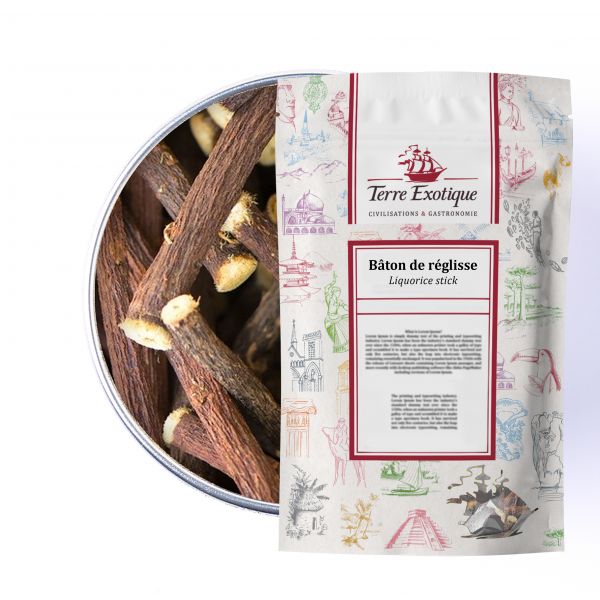
Licorice Stick, to Infuse or Chew
These sweet and bitter licorice sticks can be chewed like candy! When infused, they flavor syrups, creams, and sauces for fish.
How to Cook with Licorice Sticks?
To use it, simply break the stick into small pieces and add it to hot liquids like infusions, broths, or sauces to release its aromas. In desserts, you can let it infuse in creams or syrups to flavor crème brûlées, ice creams, or fruit compotes. In savory dishes, it adds an original touch to marinades for meats, stews, or reduced sauces, often combined with citrus fruits or warm spices like cinnamon and star anise that are consumed mixed or infused with other ingredients.
Recipe Ideas for Using Licorice Sticks
- Licorice Infusion: infuse pieces of licorice stick in hot water for a soothing tea;
- Licorice Syrup: infuse licorice in a sugar syrup to sweeten and flavor cocktails or desserts;
- Apple Compote with Licorice: add pieces of licorice stick while cooking apples for a deliciously flavored compote;
- Licorice Crème Brûlée: infuse the cream with pieces of licorice stick before preparing the crème brûlée;
- Licorice-Poached Fish: add pieces of licorice stick to a court-bouillon for poaching fish;
- Red Wine Sauce: add a licorice stick while reducing a red wine sauce to accompany red meat.
They can also be used to curb the desire to smoke or to quench thirst. Licorice contains glycyrrhizic acid, which has a consumption limit. The maximum daily intake of glycyrrhizic acid is 3 mg per kilogram per day.
What Are the Aromas of Licorice Stick?
The licorice stick is characterized by its distinct and complex aromas, combining sweet and anise notes with a slight bitterness. When used in cooking, it releases warm and comforting flavors reminiscent of anise and black licorice. These aromas can vary in intensity depending on the cooking method and infusion time.
The Botanical Origin of Licorice
The licorice stick comes from the root of the Glycyrrhiza glabra plant, a species of licorice mainly native to the Mediterranean regions and Western Asia. This plant belongs to the Fabaceae family and grows in humus-rich soils, often near watercourses. Licorice roots contain natural compounds that give the plant its distinctive sweet taste and characteristic aroma. Once harvested, the roots are cleaned, dried, and sometimes used in whole stick form or ground into powder.
Licorice, a Miraculous Product
The word licorice is derived from the Latin glycyrrhiza, which literally means "sweet root". Linnaeus retained the Greek name as the botanical genus name for licorice. Theophrastus wrote in 300 BC that licorice has "the power to suppress thirst if kept in the mouth". At that time, the combination of licorice, easy to chew, and long-lasting dry cheese was a great provision for traveling nomads.
| Price/kg | 54,3 |
|---|---|
| Allergen | Absence |
| Native country | TURQUIE/SYRIE |
| Genus and botanical species | Glycyrrhiza glabra |
| Ingredients | liquorice stick |
| Contenance | 500g |
| TRACES EVENTUELLES D'ALLERGÈNES | céleri, sésame, moutarde, fruits à coques. |
 Français
Français 